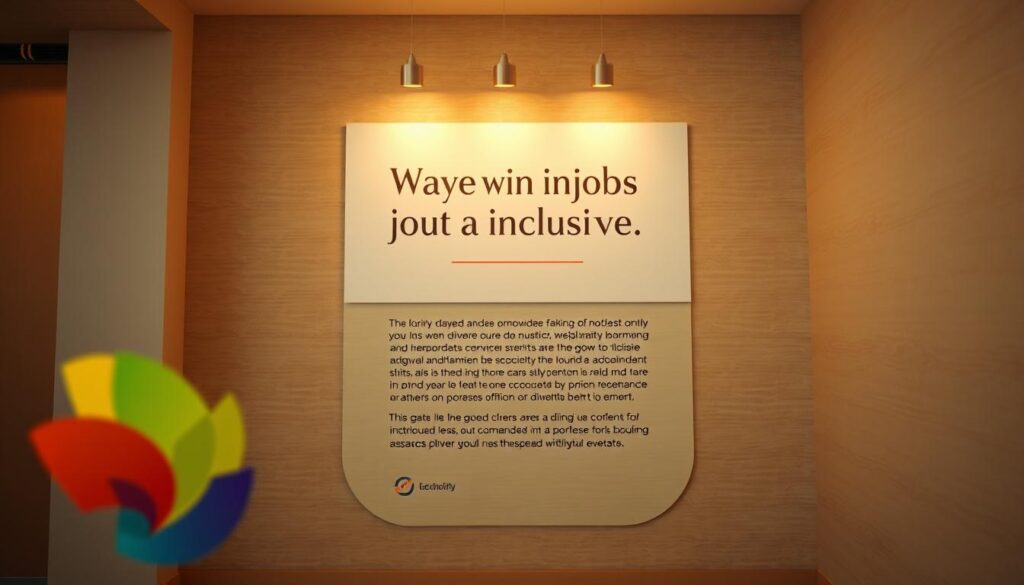Have you ever wondered why some companies attract a diverse pool of candidates while others struggle? The answer often lies in the language used in their job listings. Words have the power to include or exclude, and in today’s competitive market, getting it right is crucial.
Modern tools analyze billions of job listings to identify patterns that resonate with a wide range of candidates. By leveraging data, companies can craft descriptions that appeal to a broader audience, ensuring fairness and inclusivity. This approach not only enhances diversity but also improves hiring efficiency and engagement1.
Understanding the connection between language and recruitment outcomes is essential. Clear, inclusive phrasing helps attract the right talent while reflecting your company culture. It’s not just about filling a role—it’s about building a team that thrives on diversity and innovation.
Key Takeaways
- Language in job listings plays a critical role in attracting diverse candidates.
- Data-driven tools analyze patterns to improve recruitment outcomes.
- Inclusive language fosters fairness and broadens candidate appeal.
- Clear phrasing reflects company culture and enhances engagement.
- Effective job descriptions save time and improve hiring efficiency.
Introduction: The Evolution of Job Postings and Inclusive Hiring

The way companies approach recruitment has transformed dramatically over the years. Traditional methods are being replaced by innovative strategies that prioritize inclusion and equity. This shift reflects broader cultural changes and the growing importance of attracting a diverse pool of candidates.
The Changing Landscape of Recruitment
Recruitment is no longer just about filling roles. It’s about building teams that reflect the values of your organization. Companies that champion diversity have a 25% higher chance of financially outperforming those that do not2. This makes inclusive hiring not just a moral imperative but a business advantage.
Modern tools now analyze billions of profiles to identify the best candidates. These platforms aggregate data from multiple sources, improving efficiency and match rates2. By leveraging these insights, companies can ensure their hiring practices are fair and effective.
How Data-Driven Insights Are Shaping Job Descriptions
Data is at the heart of this evolution. Real-time datum helps refine the language used in job descriptions, making them more inclusive and appealing. For example, balancing “we” versus “you” and incorporating growth mindset language can significantly broaden candidate appeal3.
Predictive analytics also play a crucial role. They identify candidates who may not be actively looking but are likely to be interested in new opportunities2. This approach not only enhances diversity but also improves hiring efficiency.
By embracing these changes, organizations can create a hiring process that benefits both the candidate and the company. Learn more about how modern tools are reshaping recruitment here.
Why Diversity, Equity, and Inclusion Matter

Building a workplace that thrives on diversity and inclusion isn’t just a trend—it’s a necessity for modern organizations. Companies that prioritize these values see tangible benefits, from faster hiring to stronger team dynamics. A recent study found that postings with strong DEIB messages fill positions 30% faster and attract a broader pool of candidates4.
Understanding the Impact on Your Organization
Diversity and inclusion go beyond just meeting quotas. They directly influence your process and outcomes. For example, diverse teams are 35% more likely to outperform their peers financially4. This is because varied perspectives lead to innovative solutions and better decision-making.
Inclusive practices also improve team morale and retention. When employees feel valued, they’re more likely to stay and contribute to your organization’s success. Spending a little more time on cultivating an inclusive culture pays off in the long run.
Commitment Beyond the EEO Statement
True commitment to diversity, equity, and inclusion means embedding these values into every aspect of your hiring process. It’s not just about checking boxes—it’s about creating a welcoming environment for all candidates. This includes using inclusive language in job descriptions and ensuring your managers are trained to recognize and mitigate bias.
For instance, job postings that emphasize growth opportunities and a collaborative role attract a wider range of applicants3. This approach not only broadens your candidate pool but also ensures a higher quality of hires.
By focusing on diversity and inclusion, you’re not just improving your hiring process—you’re building a stronger, more innovative organization. Learn more about how to enhance your content and tone in job descriptions here.
Textio: Optimizing Job Postings for Diversity and Inclusion – A How-To Guide

Crafting a job post that resonates with a diverse audience requires more than just listing qualifications. It’s about using language that reflects your organization’s values and appeals to a wide range of candidates. This guide will walk you through key strategies to create inclusive and engaging job posts.
Incorporating Growth-Mindset and Inclusive Language
Growth-mindset language focuses on potential and learning rather than fixed abilities. Phrases like “opportunities to grow” or “we value curiosity” signal that your organization supports development. This approach attracts candidates who are eager to learn and adapt5.
Inclusive language ensures that your job post doesn’t unintentionally exclude certain groups. For example, avoid gendered terms like “rockstar” or “ninja.” Instead, use neutral phrases like “collaborative team player.” This small change can make a lot of difference in broadening your candidate pool6.
Balancing “We” vs. “You” in Your Job Listings
Using “we” emphasizes your organization’s culture and values. It creates a sense of belonging and teamwork. For example, “We believe in innovation” highlights your collective mission. On the other hand, “you” focuses on the candidate’s role and responsibilities. Balancing both pronouns creates a well-rounded job post.
For instance, “You will lead projects, and we will support your growth” combines individual impact with team support. This balance makes the post more engaging and authentic. It also reflects a forward-thinking initiative that candidates value5.
By following these steps, you can craft job posts that attract a diverse and talented pool of candidates. For more tips on refining your hiring process, check out this guide on AI tools.
Data-Driven Best Practices for Crafting Effective Job Descriptions

Creating a job description that attracts the right talent starts with understanding what candidates truly seek. By leveraging data, you can craft posts that resonate with seekers and reduce time-to-fill positions significantly7.
Leveraging Predictive Language Analytics
Predictive analytics can fine-tune your job description to attract the right candidates. For example, using growth-mindset language like “opportunities to learn” can increase applications by 25%5. These tools analyze linguistic patterns to recommend ideal phrasing, ensuring your post appeals to a broader audience.
Real-time data also helps identify candidates who may not be actively looking but are likely to be interested in new roles7. This approach not only enhances diversity but also improves hiring efficiency.
Utilizing Industry-Specific Language Tips
Tailoring your post to industry-specific needs can make a significant difference. For instance, tech roles benefit from phrases like “innovative solutions” or “cutting-edge technology.” This specificity attracts candidates with the right skills and experience.
Data shows that industry-specific language reduces time-to-fill by up to 11 days7. By aligning your description with what seekers in your field value, you can create a more compelling and accurate representation of the role.
For more insights on using AI tools to refine your hiring process, check out this guide.
Structuring Your Job Listing for Maximum Impact
The structure of your job listing can make or break its effectiveness in attracting top talent. A well-organized post not only grabs attention but also keeps candidates engaged from start to finish. By focusing on readability and clarity, you can ensure your listing stands out in a competitive market.
Optimizing Sentence Structure, Word Count, and Punctuation
Short, concise sentences are key to maintaining reader interest. Aim for an average sentence length of 15-20 words. This makes your post easy to scan and understand. Avoid long, complex sentences that can confuse or overwhelm candidates.
Punctuation also plays a crucial role. Overusing exclamation marks can come across as unprofessional. Instead, use periods and commas to create a natural flow. Proper punctuation enhances readability and ensures your message is clear8.
Strategic Use of Bullet Points and Visual Breaks
Bullet points are a powerful tool for breaking down information. They highlight key responsibilities and qualifications, making it easier for candidates to quickly assess the role. Use them to list essential skills or benefits, but keep each point concise.
Visual breaks, such as white space or subheadings, improve readability. They give the reader’s eyes a rest and make the content more digestible. A well-structured post not only attracts more applicants but also reflects your brand’s professionalism3.
By refining these structural elements, you can create a job listing that resonates with your target audience. For more tips on enhancing your hiring process, explore this guide on AI tools.
Harnessing Textio’s Insights for a Competitive Employment Brand
In today’s competitive hiring landscape, your company’s communication style can be the deciding factor for top talent. By leveraging data-driven insights, you can refine your messaging to attract the right applicants and build a strong employment brand. This approach ensures your workplace culture is accurately represented, fostering trust and engagement from the start.
Evaluating Your Company’s Communication Style
Your communication style reflects your company’s values and culture. Using tools like Textio’s platform, you can assess whether your messaging resonates with your target audience. For example, clear and inclusive language can increase applicant engagement by up to 30%9. This ensures your recruiters are aligned with your brand’s mission and values.
Structured feedback and data-driven insights help identify areas for improvement. By focusing on skills-based evaluations, you can reduce subjective judgments and create a fairer hiring process10. This approach not only enhances your ability to attract diverse talent but also improves overall hiring efficiency.
Enhancing Candidate Engagement and Attraction
Engaging candidates starts with authentic communication. Job postings that emphasize growth opportunities and collaborative environments attract a wider range of applicants9. This strategy ensures your workplace is seen as inclusive and supportive, which is a key factor for many job seekers.
Using precise language in your job descriptions can also improve your recruitment outcomes. For instance, roles that focus on skills rather than formal education see a 30% rise in diverse candidates applying9. This approach aligns your messaging with market expectations and enhances your competitive edge.
By refining your communication style and leveraging data-driven insights, you can create a hiring process that attracts high-quality applicants and strengthens your employment brand. For more strategies on optimizing your hiring process, explore Textio’s platform.
Conclusion
Effective hiring strategies are built on clear, inclusive communication and continuous improvement. By refining your language and practices, you can attract a wider range of employees and meet your hiring requirements more efficiently11.
Thoughtful language choices and inclusive practices not only shorten the hiring process but also enhance the candidate experience. This approach ensures your organization appeals to a diverse pool of talent, driving measurable growth in recruitment outcomes12.
Continuous refinement is key. Leveraging data-driven insights helps you stay ahead in a competitive market. Apply the guidance provided to create a hiring process that aligns with your organization’s goals and values.
Every number and data point mentioned is part of a larger strategy to achieve success. By focusing on these actionable insights, you can build a stronger, more inclusive workplace that attracts top talent and fosters innovation.
FAQ
How can inclusive language improve my job descriptions?
What role does data play in crafting effective job listings?
Why is diversity important in the hiring process?
How can I balance “we” and “you” in my job postings?
What are some best practices for structuring job listings?
How can I evaluate my company’s communication style in job postings?
What are the benefits of using predictive language analytics?
How can I enhance candidate engagement through job postings?
Source Links
- How AI Supports Call Center Workforce Diversity & Inclusion Initiatives – Insight7 – AI Tool For Interview Analysis & Market Research
- 10+ Best Talent Sourcing Tools for Recruiters in 2025
- American Express Jobs in March, 2025 (Hiring Now!)
- arXiv:2503.06002v1 [cs.HC] 8 Mar 2025
- Top 10 AI Job Description Generators for 2025 | ClickUp
- The Very Best AI Recruitment Tools For Businesses in 2025
- 12 Talent Acquisition Resume Examples for 2025
- The 50 Best AI Tools in 2025 (Tried & Tested)
- Technology Supporting Diversity and Inclusion Initiatives
- New AI-powered tools from Textio bring a skills-based structure to the interview process
- The RealReal hiring Customer Experience Specialist – Greenwich in Greenwich, CT | LinkedIn
- Amplitude hiring Enterprise Account Executive in San Francisco Bay Area | LinkedIn







